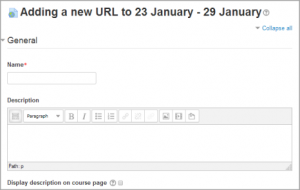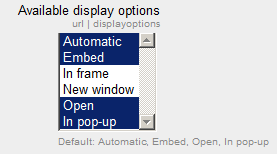URL resource settings: Difference between revisions
Mary Cooch (talk | contribs) (updating and tweaking) |
Mary Cooch (talk | contribs) (updating and tweaking) |
||
| Line 1: | Line 1: | ||
{{URL}} | {{URL}} | ||
==Adding a URL resource to your course== | ==Adding a URL resource to your course== | ||
# Turn editing on | # Turn editing on. | ||
#From the the "Add an activity or resource" link (or, if not present, the "Add a resource" drop down menu),choose URL. All settings may expanded by clicking the "Expand all" link top right. | #From the the "Add an activity or resource" link (or, if not present, the "Add a resource" drop down menu),choose URL. All settings may expanded by clicking the "Expand all" link top right. | ||
==General== | |||
{| | |||
|[[File:urlgeneral25.png|thumb|General settings expanded by default]] | |||
|} | |||
===Name=== | |||
Whatever you type here will form the link learners click on to view the URL so it is helpful to give it a name that suggests its purpose. | |||
===Description=== | |||
Add a description of your page here. Click "Show editing tools" to display the rich text editor, and drag the bottom right of the text box out to expand it. | |||
===Display description on the course page=== | |||
If this box is ticked, the description will appear on the course page just below the name of the URL. | |||
==Content== | |||
{| | {| | ||
| [[File: | |[[File:Url.png|thumb|External URL field expanded by default]] | ||
|} | |} | ||
== | # Either enter the URL in the external URL field or click the "Choose a link" button to open the file picker and choose a URL YouTube, Picasa etc (depending on which [[Repositories|repositories]] are enabled for the site. | ||
==Appearance== | |||
(These settings are collapsed by default) | |||
{| | |||
|[[File:urlappearance25.png|thumb|Appearance settings expanded]] | |||
===Display | |} | ||
===Display=== | |||
* ''Automatic'' - Make the best guess at what should happen (probably what is wanted 99% of the time). | * ''Automatic'' - Make the best guess at what should happen (probably what is wanted 99% of the time). | ||
| Line 22: | Line 38: | ||
* ''Open'' - No Moodle heading, blocks, footer or description - just show the file in the web browser (e.g. shows image, PDF, flash animation, taking up the whole browser window) | * ''Open'' - No Moodle heading, blocks, footer or description - just show the file in the web browser (e.g. shows image, PDF, flash animation, taking up the whole browser window) | ||
* ''In pop-up'' - Same as 'Open', but opens a new browser window to show this file (without the Moodle heading, blocks, etc) - this browser window also does not have all the menus and address bar in it. | * ''In pop-up'' - Same as 'Open', but opens a new browser window to show this file (without the Moodle heading, blocks, etc) - this browser window also does not have all the menus and address bar in it. | ||
There above options are the default display options. Additional display options (see below) may be enabled by an administrator in ''Site administration > Plugins > Activity modules > URL''. | There above options are the default display options. Additional display options (see below) may be enabled by an administrator in ''Site administration > Plugins > Activity modules > URL''. | ||
===Pop-up width/height=== | |||
If your URL is to be displayed in a pop-up, specify the width and height here. | |||
====Display URL name/description==== | |||
To show the resource name and/or description when clicking to access the URL, simply tick the appropriate checkboxes. | |||
== | ==URL variables== | ||
(These settings are collapsed by default.) | |||
{| | |||
|[[File:urlvariables25.png|thumb|URL variables settings expanded]] | |||
|} | |||
Thissection allows you to pass internal information as part of the URL. | |||
This is useful if the URL is actually an interactive web page that takes parameters, and you want to pass something like the name of the current user, for example. | This is useful if the URL is actually an interactive web page that takes parameters, and you want to pass something like the name of the current user, for example. | ||
Revision as of 10:16, 6 May 2013
Adding a URL resource to your course
- Turn editing on.
- From the the "Add an activity or resource" link (or, if not present, the "Add a resource" drop down menu),choose URL. All settings may expanded by clicking the "Expand all" link top right.
General
Name
Whatever you type here will form the link learners click on to view the URL so it is helpful to give it a name that suggests its purpose.
Description
Add a description of your page here. Click "Show editing tools" to display the rich text editor, and drag the bottom right of the text box out to expand it.
Display description on the course page
If this box is ticked, the description will appear on the course page just below the name of the URL.
Content
- Either enter the URL in the external URL field or click the "Choose a link" button to open the file picker and choose a URL YouTube, Picasa etc (depending on which repositories are enabled for the site.
Appearance
(These settings are collapsed by default)
Display
- Automatic - Make the best guess at what should happen (probably what is wanted 99% of the time).
- Embed - Show the Moodle page with heading, blocks and footer. Show the title/description of the item and display the file directly in the page as well
- Open - No Moodle heading, blocks, footer or description - just show the file in the web browser (e.g. shows image, PDF, flash animation, taking up the whole browser window)
- In pop-up - Same as 'Open', but opens a new browser window to show this file (without the Moodle heading, blocks, etc) - this browser window also does not have all the menus and address bar in it.
There above options are the default display options. Additional display options (see below) may be enabled by an administrator in Site administration > Plugins > Activity modules > URL.
Pop-up width/height
If your URL is to be displayed in a pop-up, specify the width and height here.
Display URL name/description
To show the resource name and/or description when clicking to access the URL, simply tick the appropriate checkboxes.
URL variables
(These settings are collapsed by default.)
Thissection allows you to pass internal information as part of the URL.
This is useful if the URL is actually an interactive web page that takes parameters, and you want to pass something like the name of the current user, for example.
Common module settings
Restrict access/Activity completion
(These settings are collapsed by default)
These settings are visible if Conditional activities and Activity completion have been enabled in the site and the course.
Drag and Drop a URL
Alternatively, if an administrator has enabled the experimental feature drag and drop upload of text/links in Settings > Site administration > Development > Experimental > Experimental settings, a link can be dragged into a section of the course and given a name, as shown in the images below.
URL module capabilities
Site administration settings
The URL module has additional settings which may be changed by an administrator in Settings > Site administration > Plugins > Activity modules > URL.
Frame height
Here you can specify the height of the top frame (containing the navigation) if you choose the "in frame" display option. Note:If your theme has a large header then the height should be increased to prevent horizontal and vertical scrollbars.
Require activity description
This setting allows you to turn off the requirement for users to type something into the description box.
Password
Here you can add a password that will connect your users to a secure site. See this forum post for more details.
Include role names in parameters
Available display options
This setting allows you to add different ways the resource may be displayed on the course page. There are a number of defaults but you can add or change them here. Other display options are:
- In frame - show the Moodle heading and the file description, with the file displayed in a resizable area below
- New window - very much like 'in pop-up', but the new window is a full browser window, with menus and address bar, etc.
Default values for activity settings
Here you can set the defaults for this resource. You can also choose which setting(s) to class as "Advanced". These settings will only then appear if the user clicks "Show advanced" in the settings.




